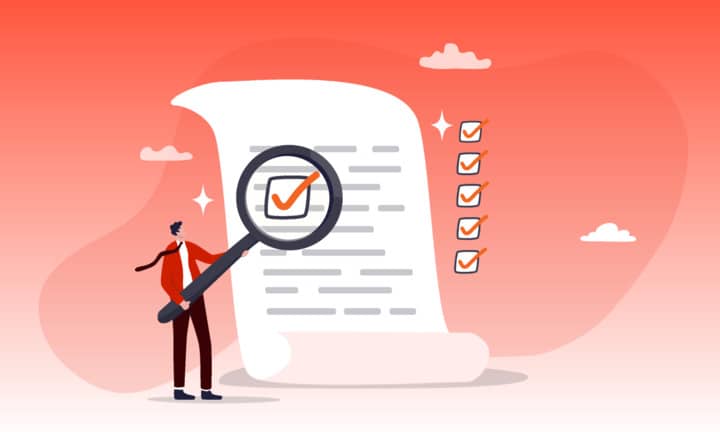

Lead qualification is a crucial part of building and sustaining a predictable sales pipeline. Without it, you risk chasing leads with little to no impact, resulting in wasted time and energy from your sales, marketing, and sales development teams.
While there is no wrong way to qualify leads in B2B lead generation, there are some lead qualification processes and best practices that are more effective than others, resulting in better sales meetings and more revenue generated.
In this blog, we’ll highlight the following topics:
What Is Lead Qualification?
Lead qualification refers to the process of evaluating and categorizing prospects and/or leads who have shown interest in a product, service, or solution. The primary goal of lead qualification is to determine the likelihood that a prospect will eventually convert into a paying customer. This evaluation involves assessing various factors, such as the prospect’s needs, budget, authority, timeline, and fit with the offering (which we’ll expand on later).
While lead qualification is one of the earlier stages of the B2B sales process, it’s one of the most crucial because it ensures that sales reps are chasing leads that are likely to convert into sales. Without a lead qualification process in place, you risk wasting valuable company time, money, and resources on leads that are unlikely to purchase.
Lead qualification encompasses both objective and subjective components. To objectively qualify a lead, it’s important to think about what you consider a qualified prospect. Many B2B companies objectively qualify leads by gathering the following information:
- Square footage of a prospect’s commercial building
- Number of full-time employees (or workspaces)
- Amount of revenue generated per year
As you consider your lead qualifiers, it’s essential to consider your industry. For example, commercial companies often focus on the square footage of the prospect’s commercial building. More often than not, they shoot for over 10,000 square feet because they know they’re more likely to get an ROI. If they don’t meet these qualifiers, they often consider the number of full-time employees they have. However, when it comes to companies in the IT and software industry, their qualifiers include the number of workspaces a prospect has.
On the other hand, the subjective component of lead qualification involves determining how likely a prospect is to buy based on their stage in the B2B marketing and lead generation funnel. If they’re actively looking for solutions to their pain points, they’re more ready to buy than prospects who just meet the objective lead qualifiers. Understanding the subjective component of lead qualification is especially important for companies that take advantage of an outbound lead generation and B2B appointment setting strategy, because it helps sales development representatives (SDRs) know when to effectively follow up with the lead.
What Makes Lead Scoring Different From Lead Qualification?
Lead scoring serves as a subset of lead qualification, occuring after a lead is qualified by an SDR.
While lead qualification revolves around forecasting the potential conversion of a prospect into a customer, lead scoring compares all qualified leads against each other based on their objective and subjective lead qualifiers, typically ranging from 0 to 100.
For example, let’s say there are two leads in your sales pipeline that serve the same industry and have the same number of full-time employees. However, one lead’s commercial contract ends in the next month, but the other lead still has nine months until they reevaluate their contracts. In this case, the first lead would score higher because they’re closer to the end of the sales cycle. While you don’t want to forget about the second lead, they’re not as much of a priority as the one who is ready to make a purchasing decision.
Why Should Sales and Marketing Qualify Leads?
Lead qualification is an important part of the sales process because it saves sales and marketing teams time, money, and energy from chasing leads that are unlikely to make a purchase or result in little to no ROI.
It’s crucial to implement lead qualification into the early stages of your sales process to ensure they’re worth your efforts. Overall, lead qualification helps you and your sales teams determine if a prospect:
- Meets your ideal customer profile
- Could benefit from your company’s product or service
- Has a need for what your company has to offer
- Has the budget and authority to make a purchasing decision
- See the value in your company’s product or service
While disqualifying a lead may sound like a bad thing, it allows your sales and marketing team to put their energy toward more promising leads. Once an unqualified lead is out of the sales pipeline, your SDRs can gear their attention to prospects that are a part of your target audience.
The lead qualification process looks different depending on how the lead enters the sales pipeline. When practicing an outbound lead generation or B2B appointment setting strategy, individuals enter the pipeline through lists generated from sales and data analysts. These professionals can build prospect lists through a variety of methods, including purchasing lists from an outsourced data company, or finding potential buyers online through social media. Tools like LinkedIn Sales Navigator makes this easier for outbound sales teams to find prospects.
Leads can also enter the sales pipeline by filling out a contact form fill or downloading a lead magnet online, often done through company websites, social media ads, and landing pages. This process is the overall goal for inbound lead generation (or inbound marketing). Once a user submits their information, they’re considered a marketing qualified lead (MQL) because they’ve expressed interest in your company’s product or service offerings. From here, it’s up to SDRs to reach out to the MQL and convert them into a sales qualified lead (SQL).
There tends to be a lot of confusion around who is responsible for lead generation: sales or marketing? To learn about the roles of both of the departments when it comes to sustainable business growth, read our blog here.
How to Convert an MQL Into an SQL
Today, MQLs are often generated through digital marketing efforts. Decision-makers can find your business through different platforms like your company website and social media platforms. Marketing teams can make their website more visible to their target audience by practicing search engine optimization (SEO) or promoting content through social media ads.
If an interested user sees value in what your company offers, they can submit their contact information to schedule a sales meeting or sign up for additional sales and marketing materials. Once a user inputs their information, they’re converted into an MQL. From here, it’s the job of the sales development rep to reach out to the interested buyer to learn more about their company. This conversation strives to help sales teams explore how they can help the MQL and how the MQL can mutually benefit their business.
After the SDR connects with the prospective business, they determine whether or not they’re also an SQL. If they are and they’re ready to take the next step in the customer lifecycle, they set their account executives up with a sales appointment where they can present the qualified lead with a personalized sales presentation. However, if they don’t meet the predetermined criteria of your business, they’re excused from the sales funnel because they have little to no likelihood of closing business.
Different Types of Lead Qualification Strategies
The lead qualification process typically happens in one of these four strategies: BANT, GPCTBA/C&I, CHAMP and MEDDIC. Here’s a breakdown of what goes into each of these different lead qualification strategies:
BANT
BANT stands for Budget, Authority, Need, and Timeline—four critical criteria for evaluating a lead’s potential to convert into a customer.
- Budget refers to the lead’s financial capacity to afford the offered product or service
- Authority determines if the lead has the decision-making power to finalize a purchase
- Need involves assessing whether the lead’s requirements align with what the product or service can provide
- Timeline evaluates the lead’s urgency and the timeframe within which they intend to make a decision
Applying the BANT lead qualification strategy allows organizations to effectively prioritize leads based on their likelihood to result in successful conversions. However, it’s important to note that the BANT approach may not fully capture the complexities of modern buyer behavior, as it focuses mainly on quantifiable factors and doesn’t consider factors like engagement or relationship-building. As a result, some businesses supplement BANT with additional lead scoring models or strategies to create a more comprehensive lead qualification process.
GPCTBA/C&I
GPCTBA/C&I is a comprehensive lead qualification strategy, developed by HubSpot, that stands for Goals, Plans, Challenges, Timeline, Budget, Authority, Negative Consequences, and Positive Implications/Critical Events.
- Goals involve understanding the lead’s objectives and what they aim to achieve with a product or service
- Plans refer to the strategies they have in place to reach those goals
- Challenges help identify the obstacles they face
- Timeline gauges their urgency in making a decision
- Budget assesses their financial capacity
- Authority determines if they have decision-making power
- Negative Consequences examine the risks of not addressing their challenges
- Positive Implications/Critical Events explore the potential benefits of adopting the offering
This strategy goes beyond BANT by incorporating qualitative factors and focuses on building a deeper understanding of the lead’s needs and motivations. It facilitates more meaningful conversations, nurtures relationships, and aligns offerings with lead expectations. As the buyer-seller dynamic evolves, GPCTBA/C&I provides a modern approach to lead qualification, reflecting the complexities of the buyer’s journey and fostering a customer-centric sales process.
CHAMP
CHAMP is a modern approach to lead qualification, standing for Challenges, Authority, Money, and Prioritization.
- Challenges involve understanding the specific pain points and obstacles a lead is facing
- Authority gauges the decision-making power of the lead within their organization
- Money evaluates the financial resources available for investing in a solution
- Prioritization involves determining the lead’s level of urgency and how high their need is on their list of priorities
CHAMP shifts the focus from traditional factors like budget and timeline to a more comprehensive understanding of a lead’s situation. It recognizes that modern buyers are influenced by a variety of factors, and their decision-making process is nuanced. Addressing the lead’s challenges, acknowledging their authority, aligning with their financial capacity, and recognizing their prioritization empowers sales, marketing, and sales development teams to engage leads in more meaningful ways, foster trust, and tailor their solutions to meet the lead’s specific needs effectively. This approach ensures a more customer-centric and personalized lead qualification process.
MEDDIC
MEDDIC lead qualification strategy is a systematic lead qualification strategy that stands for Metrics, Economic Buyer, Decision Criteria, Decision Process, Identify Pain, and Champion.
- Metrics involve quantifiable measures that determine the potential value of the solution to the lead’s business
- Economic Buyer refers to identifying the person with the authority to make purchasing decisions
- Decision Criteria entails understanding the specific factors that influence the lead’s decision-making process
- Decision Process involves mapping out the steps and stakeholders involved in the lead’s buying journey
- Identify Pain focuses on uncovering the lead’s pain points and challenges
- Champion pertains to finding an internal advocate who champions the solution within the lead’s organization
Following the MEDDIC lead qualification framework allows sales teams to gather comprehensive insights into a lead’s needs, motivations, and decision-making dynamics. This approach emphasizes the importance of understanding both the lead’s quantitative and qualitative aspects, ensuring a tailored and effective engagement strategy. MEDDIC aids in building strong relationships, mitigating obstacles, and aligning the solution with the lead’s unique requirements, ultimately increasing the likelihood of successful conversions and long-term customer satisfaction.
How to Qualify Leads in the Sales Pipeline
Lead qualification involves asking prospects a wide range of questions to learn more about them and what they’re looking for in a B2B product or service provider. Here are some of the ways your SDRs can qualify sales leads and guide them to their next step in the sales cycle:
Ask Lead Qualifying Questions
Many B2B companies have specific qualifications a potential customer has to meet to do business with their company. This ensures that the business receives a positive ROI with the products or services they provide the client.
For example, many companies like commercial HVAC and cleaning require at least 10,000 square feet of air-conditioned or cleanable space. Additionally, many commercial cleaning programs require at least three days of ongoing cleaning services.
Asking leads about the size of the commercial space (or how often they clean their facility) enables SDRs to know if they’re a sales qualified lead. If they are, they can continue providing value to pique their interest and convert them to be both a marketing and sales qualified marketing lead.
Ask Questions to Uncover Pain Points
More often than not, a sales-qualified lead isn’t going to agree to a sales appointment right off the bat, which is why it’s essential to ask open-ended questions to learn more about the prospect and uncover where there could be areas for improvement. Asking questions to discover pain points is vital because it empowers your sales team to give the prospect and solution and provide value to your business.
Let’s say you’re an MSP, and your SDRs ask a prospect what they expect from an IT partner, and they say that they want a 24/7 help desk in case their network goes down, but their current provider doesn’t supply that. To give value to your business, your SDRs can talk about your 24/7 help desk and how it has helped customers with the same concerns.
Asking pain point-focused questions opens the door for better conversations and allows SDRs to provide case studies of how your company has been impactful for customers in similar scenarios. This encourages the lead to picture themselves in the shoes of your customer.
Ask About Their Decision-Making Process
Every business has its own way of making financial decisions. To qualify leads, SDRs must ask decision-makers about their decision-making processes. Are they the only ones in charge of purchasing that specific product or service? Is there someone else who’d be more fit to talk with about the products or services you offer? What does the timeline look like when making company purchases?
Asking these process-focused questions helps SDRs set account executives up with productive sales meetings that are likely to convert into closed business. Without a solid understanding of their decision-making process, you risk extending the amount of time they’re in the sales cycle.
Lead Qualification Best Practices
While there are many ways sales and marketing teams can practice lead qualification, there are some best practices they should be aware of to make sure they get the most out of their business growth efforts. A few of the lead qualification best practices your sales team should follow include:
Define What a Qualified Lead Means to Your Business
Before jumping into the sales pipeline and pitching decision-makers, you must consider what a qualified lead means to you and your business. A qualified lead means something different to every business in each industry, so it’s vital that sales teams know what kinds of opportunities to look for and which ones to avoid.
For example, let’s say your business only works with nonprofit organizations. If an SDR is unaware and schedules a sales meeting with a for-profit company, they’re not qualified, and this appointment would be a bust for both the prospect and your account executives. When identifying what a qualified lead means to your business, it’s crucial that it’s shared with every department so messaging stays consistent for a positive prospect experience.
Ask Relevant, Customer-Focused Questions
Every question an SDR asks should be relevant and put the potential customer at the forefront of the conversation. While sales reps are naturally sociable people, it’s important that they spend time asking prospects questions to learn more about them and what they’d be looking for in a B2B product or service provider. This encourages them to trust what your company has to offer them because they know your company has their best interest at heart.
Test Different Lead Qualification Processes
If you’re not seeing the impact of your current lead qualification process, it may be worth making adjustments. For example, let’s say you want to test generating more business from a specific industry, so you have all your SDRs pitching that sector. However, you don’t see a lot of interest from them. While you may want to expand into these different markets, it’s not getting the ROI you want, so it may be worth expanding your reach to more industries not to sell yourself or your sales team short.
Additionally, one lead qualification strategy that works for one business may not be as effective as another. If your SDRs are presenting account executives with low-quality appointments, it may be worth trying out a new lead qualification strategy for SDRs to use in their sales process. This could allow your account executives to get better, more high-converting sales meetings.
Your Ultimate Lead Qualification Checklist
Are you following all the steps of lead qualification? Here’s a lead qualification checklist your sales and marketing teams can follow to make sure you get the most qualified prospects for your sales pipeline.
1. Do They Fit Your Ideal Customer Profile?
If the answer is yes, they’re on the right track to being a qualified sales lead. If the answer is no, then your sales and marketing teams should get them out of the sales pipeline to focus on prospects worth their time and efforts.
2. Do You Have the Correct Company and Decision-Maker Information?
Is the person SDRs are speaking with the best point of contact for your company’s product or service offerings? When SDRs call or email prospects in the sales pipeline, it’s essential that they have the correct information to ensure there’s an opportunity to close. Without accurate company information, SDRs risk setting sales appointments with an industry you don’t work with or aren’t in your service region.
Additionally, without the right decision-maker information, SDRs risk setting sales appointments with people who don’t have buying power, increasing the amount of time they spend in the sales cycle. To find the best decision-maker for your company’s product or service, you must verify the decision-maker’s name and job title. When scheduling the appointment, SDRs should ask if anyone else should be attending the meeting or if they’re the final decision-maker when making company purchases.
3. Are They Frequently Looking at Your Sales and Marketing Content?
If a prospect frequently looks at your sales and marketing content, they might be interested in making a purchase. With the right sales tools and technologies, you can see what potential buyers are engaging with on your email marketing materials. One of the best tools companies can use to see email engagement is CRM software with sales and marketing extensions. It allows your sales and marketing teams to see what emails prospects in the sales pipeline are looking at and how they venture past those emails. If they click on a link or download a file attached to the email, your lead generation experts have a bird’s eye view of their journey. This allows them to make warm phone calls and adjust their pitch based on what they’re engaging with.
4. Have They Forwardly Expressed Interest in Your Company?
While looking at sales and marketing content is a good indication of whether or not a prospect is interested in your company, it’s important to take it with a grain of salt. They may be interested in learning more, but that doesn’t mean they’re ready to buy now. If a prospect openly expresses their interest in learning more, they may be a qualified lead. However, your SDRs must still verify their objective lead qualifications.
Key Takeaways
Lead qualification is a crucial part of the sales process because it makes sure that each prospect chased by your sales and marketing team is likely to result in closed business. Many companies skip this step in their business growth approach because they either don’t have the time or have the misconception that more leads equals more business opportunities. However, this couldn’t be further from the truth, and we have a solution for you.
At Abstrakt Marketing Group, our outbound SDRs are trained to qualify leads based on our clients’ ideal customer profiles to ensure they only get the best business opportunities for their sales pipelines. Want to see why our lead qualification and appointment setting process is so successful? Schedule a demo of our outbound lead generation solution here!




